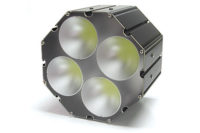
It is possible to freeze motion at 200 microseconds to adequately verify and count the ampoules. Source: Advanced Illumination
Strobe illumination, as applied to machine vision and originally borrowed from portrait photography, has evolved to include high-speed object inspection, often timed to an external event. Here we will compare and contrast continuous-on lighting vs. two strobing techniques for machine vision applications, and also suggest how each technique might be used to best meet typical inspection needs.
Of the most common vision lighting source types-LED, quartz halogen, Xenon and fluorescent-only LED and Xenon sources are well-suited to strobing. Fluorescent lighting is best suited for large area, continuous-on illumination applications requiring minimum heat output.
Continuous-On Illumination
Continuous-on or 100% duty cycle lighting is the most common form of vision illumination; duty cycle is defined as (time on / total time x 100%).The primary advantage of continuous-on vision lighting is ease of implementation and use, which generally also implies relatively low cost, all other considerations being equal. It is necessary for those applications requiring continuous inspection, such as moving Web or real-time video monitoring and recording. Two significant disadvantages of continuous-on vision lighting are lack of intensity in high-speed applications and heat build-up.
For example, while inspecting fast moving objects, such as bottles on a high-speed conveyor line, camera exposure times must be shortened dramatically to freeze motion to less than one pixel blur-the minimum necessary for an adequate inspection result. To compensate, light intensity must be increased proportionally, but there is a practical limit to the increase in intensity of continuous-on lighting because of the deleterious effects of heat build-up.

This shows the moving conveyor line at continuous-on, 500 microsecond exposure. Source: Advanced Illumination
Strobe Illumination
There are two commonly used vision lighting strobe models: simple low-current and high energy over-current drive. In both instances, the light flash is typically coordinated with the camera exposure period in response to multiple, external periodic events. Flash timing, frequency (repeat or flash rate) and duration (pulse width) are determined by either the strobe controller’s internal circuitry, or externally via a trigger event generated by a camera or part-in-place proximity signal. The primary differences between models are:1. The variation in the light flash duration vs. the camera exposure time.
2. The current levels used to power the flash.
3. The available illumination intensity per unit time during the flash.
For the simple low-current model, operated at continuous-on current output levels, the light is often on for the entire camera exposure period, typically to maximize light collection because of the relatively limited intensity. This strobe technique is well-suited for use under relatively low-speed strobing applications illuminated by high-brightness Xenon or LED lights. However, for high-speed moving objects, high energy over-current strobing offers several advantages, and although used in Xenon lamp sources, it is most often applied to LED-based vision lighting.
High energy over-current strobing relies on the fact that strobing at less than 1% duty cycle allows the light to process much more current, per unit time than would be possible at 100% duty cycle, thus increasing light output. For LED lights, the effectiveness and amount of strobe over-current capacity are most closely related to strobe duty cycle, LED and light design, thermal management strategy and drive electronics capabilities.
For a given range of applied input current values, at a fixed duty cycle, we can calculate the amount of strobe over drive potential for LED lights, expressed as a multiplicative factor of continuous-on input current levels. Most high-brightness LEDs have an effective upper limit of 6X to 8X over current capabilities, based on a typical 150 microsecond (µs) pulse width and 0.15% duty cycle. This level ensures that the heat sink can effectively dissipate the generated heat without damage to the LED bond junctions.

Under ambient factory overhead lighting at a camera exposure time of 200 microseconds, there is insufficient lighting intensity to verify the presence of pharmaceutical ampoules in the box. Source: Advanced Illumination
High energy over-current strobing takes advantage of the ability of LED and Xenon lights to dissipate heat under very short duty cycles-typically less than 1%-allowing for increased current input and thus brighter light flashes. Strobing a vision light in this fashion is advantageous because it increases lamp brightness and light life times, particularly for LED-based vision lighting. Operators should take care to differentiate between strobe techniques employing continuous current levels (also known as intermittent duty) and those employing over current drive levels because of the significant difference in the results obtained. V&S
